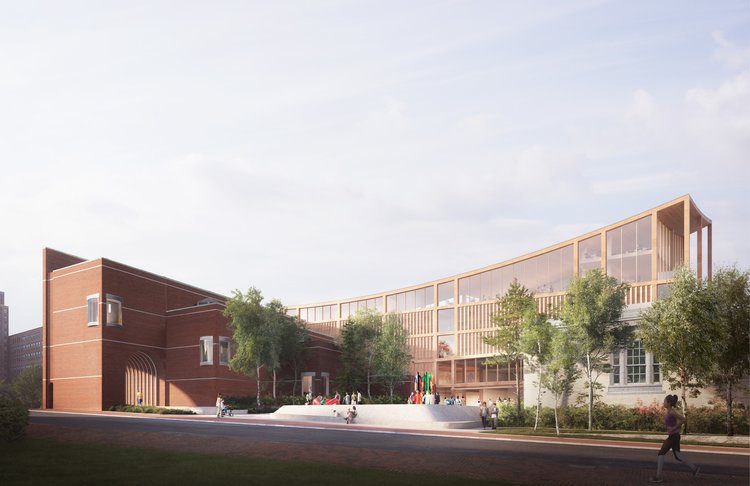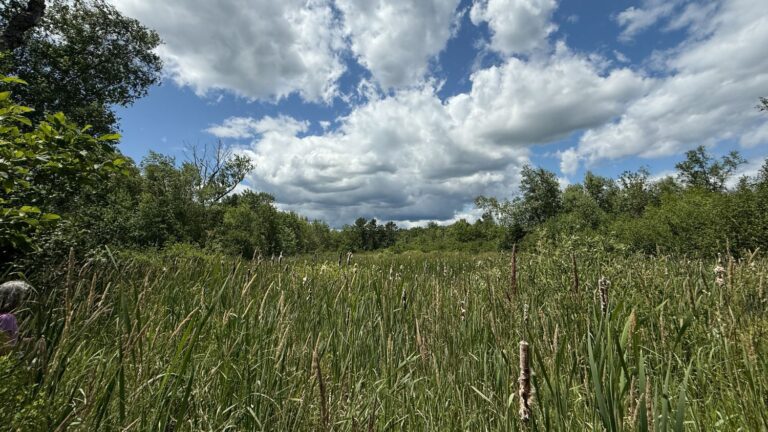Editor’s Note: The following story first appeared in The Maine Monitor’s free environmental newsletter, Climate Monitor, that is delivered to inboxes for every Friday morning. Sign up for the free newsletter to get important environmental news by registering at this link.
Every morning for the past two months, I’ve watched out my kitchen window as a small crew of workers arrives each morning and sets about doing something at once remarkable and also entirely ordinary: building a house. The flurry starts around 7 and ends at dusk, and each day I am struck by the immensity of the task before them and the resources necessary to accomplish it: chainsaws, chippers, excavators, dump trucks, hoses, concrete, steel, rebar, gravel, a truck-size generator, insulated panels, tarps, two-by-eights, two-by-fours, pipes, wires, cabinets, counters, light switches, faucets — the list goes on (and on).
It is estimated that the “built environment” — heating and lighting our homes, manufacturing the materials to build them — generates 40% of annual global CO2 emissions. Cement production alone is thought to account for eight percent of emissions, according to one report. Compare that to the roughly two percent of emissions generated by aviation, and it’s obvious that rethinking the way we build will be vital to slowing carbon emissions and staving off the most catastrophic effects of a warmer world.
LEVER Architecture, the firm that recently won a $100 million bid to design a campus expansion for the Portland Museum of Art, is hoping to do just that with a proposal to construct a soaring new wing primarily from what is known as mass timber, short for “massive timber.”
RELATED: Mass timber seen as climate solution and economic opportunity
Occasionally referred to as “plywood on steroids,” as its construction is similar, Cross-Laminated Timber (CLT) and glulam (short for “glue laminated timber”) involves gluing together and compressing large planks of sawn, dried timber, usually softwoods like spruce, pine and fir.
The resulting beams are stronger than steel and can be used to erect towers rising hundreds of feet, like the recently unveiled Mjøstårnet, or “Tower of Mjøsa,” an eighteen-story, two-hundred eighty foot architectural marvel in the riverside town of Brumunddal, Norway. Closer to home, Bowdoin College is putting the finishing touches on Maine’s first commercial mass timber structure, slated to open this spring.
Mass timber offers an attractive alternative for developers of large buildings, because rather than generating greenhouse gases during its production (like steel and concrete), trees store carbon while they’re growing and after they’ve been cut down. The timber panels are also faster to assemble and can also be cut precisely to size, which means less construction site waste. It’s also renewable: more trees can be planted to replace the ones used in building, unlike steel, which must be mined, or concrete, the base of which takes thousands of years to form.
“Maine has a tradition of using timber in structures and an incredible tradition of using timber in boat building that goes back to Wabanaki culture building canoes thousands of years ago,” said Thomas Robinson, founder of LEVER Architecture, which built the first domestically-sourced Cross-Laminated Timber office building in the United States, in Portland, Oregon.
“One of the things we’re really excited about is how do we bring back some of those industries in a way that is more sustainable,” said Robinson. “That’s something we’ve been focused on in the northwest, and there’s real momentum in the east to find ways to unlock that potential.”
Constructing large buildings out of wood not only avoids some of the more carbon-intensive materials, such as concrete, but also offers an opportunity to trap carbon in the structure itself: one cubic metre of glulam timber stores about seven hundred kilograms of carbon dioxide, according to reporting in The New Yorker, as the carbon that was trapped in the trees as they were growing remains inside.
It’s a bit counterintuitive that a tree could do more good trapping carbon in a building than in the forest (where it’s also providing a host of other benefits, like controlling erosion and acting as a vibrant participant in the local ecosystem). But advocates for mass timber say it’s a better choice than our current building materials.
“In the short term, the building industry has to do things differently,” Jørgen Tycho, founder of Oslotre, an architecture firm that works exclusively in timber, told The New Yorker last year. “And then, maybe in the long term, we will have other technologies for carbon sequestration, and green energy, and other ways of solving it. But at the moment we don’t do enough fast enough.”
Using wood as a replacement for steel and concrete is not without its complications, both in design and construction. Mass timber beams are lightweight compared to other construction materials — the tower in Norway had to be weighed down with concrete floors to prevent it from swaying in the wind and nauseating its occupants. Because of concerns around fire and water infiltration, insurance costs for mass timber buildings are often high — one Canadian study found insurance costs were five to seven times higher for tall wood buildings compared to those built with non-combustible materials.
During the construction phase, said Robinson, one of the primary challenges is where to get the timber. Choosing trees from sustainably managed forests is key — if you’re trying to reduce the amount of carbon being generated by construction, the trees being cut down must be replaced. It also means using trees that are as local as possible, since shipping them thousands of miles cancels out any benefits.
There’s long been interest in CLT and glulam in the state, but Maine currently has no manufacturers of either, said Robinson. Several flashy plans to produce mass timber have fallen apart in recent years, including one in Millinocket scuttled due to a tax lien on the former mill site and another that was shelved for reasons possibly having to do with lower labor and lumber costs elsewhere (the company, SmartLam, eventually built a plant in Alabama, with room to expand).
“It has frustrated me for the last six years that we have not been able to attract a mass timber manufacturer to Maine, the most forested state in the nation,” Matt Tonello, head of Maine operations for Consigli Construction, told Green & Healthy Maine HOMES last year.
There is the potential to source the timber in Maine, said Robinson, and have it made into structural panels in a nearby state. Robinson is also hopeful the project will help the push for mass timber regionally.
“This is the journey we’re going to embark on — to see what makes sense and see how we can leverage the materials Maine has.”
To read the full edition of this newsletter, see $100 million Portland Museum of Art expansion to be built from mass timber.
Kate Cough covers the environment for The Maine Monitor. Reach her with story ideas by email: gro.r1753907509otino1753907509menia1753907509meht@1753907509etak1753907509.








